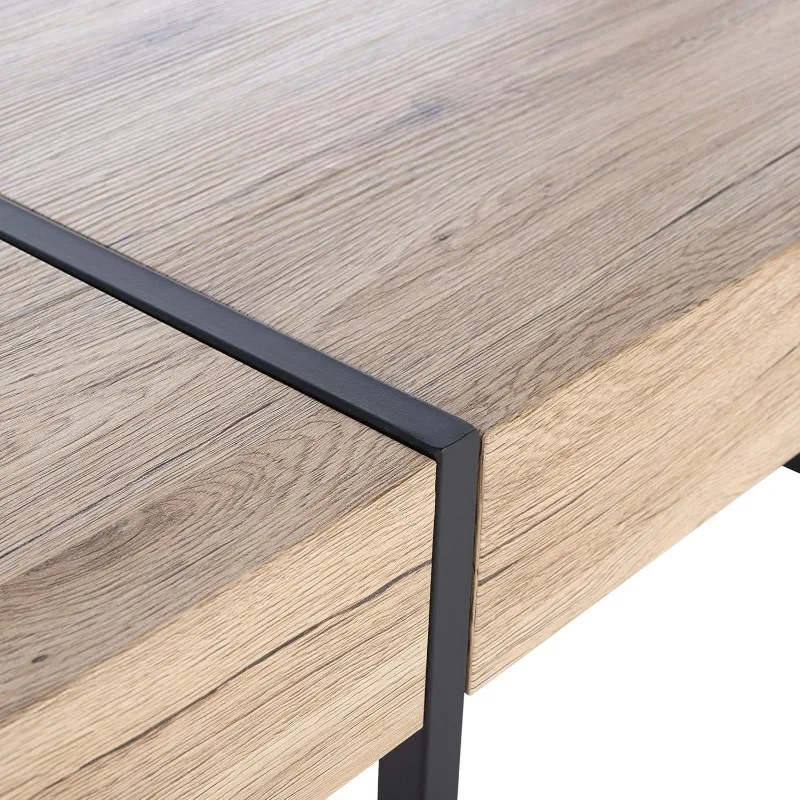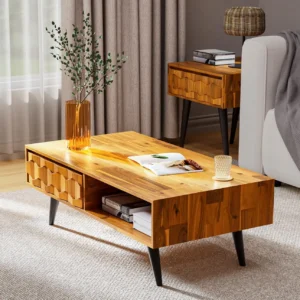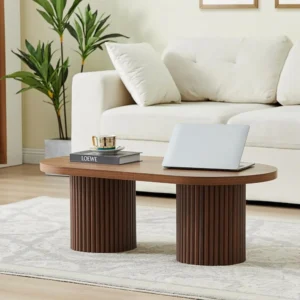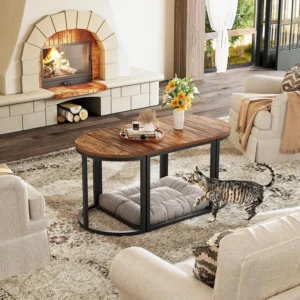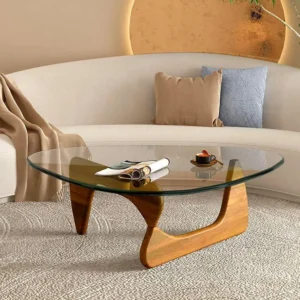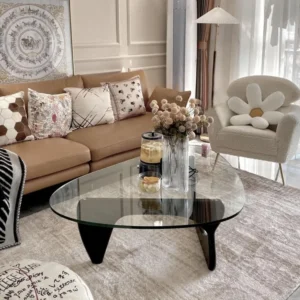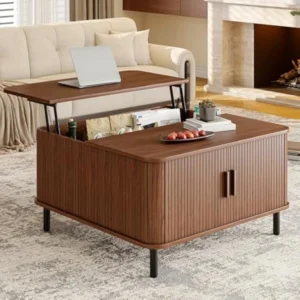Why Black Mid-Century Coffee Tables Are Timeless Design Classics
The allure of black mid-century coffee tables lies in their perfect harmony of form and function. These iconic pieces have maintained their popularity for decades, transcending fleeting design trends to become genuine classics in home furnishing. The marriage between the clean, organic lines of mid-century design and the sophisticated depth of black finishes creates pieces that feel both nostalgic and perpetually contemporary.
Black mid-century coffee tables offer remarkable versatility that few other furniture styles can match. Their sleek silhouettes and minimalist approach allow them to:
- Anchor diverse interior styles from minimalist to eclectic
- Create dramatic visual contrast in lighter spaces
- Complement virtually any color palette or decor scheme
- Showcase the distinctive materials and craftsmanship of mid-century design
What sets these pieces apart is their ability to serve as both functional centerpieces and artistic statements. The black finish highlights the sculptural quality of mid-century forms while maintaining the movement’s commitment to unpretentious elegance. Even as interior design trends evolve, these tables continue to feel fresh and relevant in modern spaces.
The enduring appeal of intelligent black mid-century coffee tables stems from their balanced proportions, quality craftsmanship, and timeless aesthetic that complements both vintage and contemporary interiors. Today’s homeowners continue to seek out these mid-century modern black coffee tables for their ability to transform living spaces with understated sophistication.
Defining Mid-Century Modern Coffee Table Design
Mid-century modern design emerged roughly between the 1940s and 1970s, representing a pivotal shift toward functional minimalism in home furnishings. This revolutionary approach to furniture design prioritized clean lines, organic forms, and democratic accessibility—principles that are particularly evident in coffee table designs from this era.
The defining characteristics of authentic mid-century coffee tables include:
- Functionality First: Every element serves a purpose with no superfluous ornamentation
- Clean, Uncluttered Lines: Simple silhouettes with an emphasis on horizontal planes
- Material Honesty: Celebrating the natural beauty of materials rather than disguising them
- Organic-Geometric Balance: Combining gentle organic curves with geometric precision
- Minimal Ornamentation: Allowing form, proportion, and materials to create visual interest
- Elevated Structures: Tables that appear to float on slender, angled legs
- Versatile Proportions: Dimensions that work harmoniously with various seating arrangements
Mid-century coffee tables revolutionized living room design by rejecting the heavy, ornate furniture of previous eras. Instead, they embraced accessible elegance through simplified forms that could be mass-produced without sacrificing quality or aesthetic appeal.
This design movement drew inspiration from various influences including Scandinavian functionalism, the Bauhaus school’s principles, and American practicality. The resulting fusion created coffee tables that felt both international and distinctly modern—tables that continue to influence contemporary furniture design today.
Understanding the fundamental elements of black mid-century coffee table design helps appreciate why these pieces remain so coveted. Their enduring popularity speaks to how successfully they balance artistry with utility—a core principle of mid-century modern coffee tables that continues to resonate with today’s design sensibilities.
The Power of Black in Mid-Century Design
Black finishes bring a distinctive sophistication to mid-century design that few other color choices can match. When applied to the clean lines and organic forms typical of this style, black creates a powerful visual statement while maintaining the era’s commitment to understated elegance.
Black serves as the perfect backdrop for showcasing the distinctive forms of mid-century design. The color’s depth enhances rather than competes with the furniture’s silhouette, allowing the eye to appreciate the sculptural quality of curved edges, tapered legs, and geometric planes. This visual emphasis on form rather than color aligns perfectly with mid-century design principles that celebrate function and honest materials.
What makes black particularly effective in mid-century design is its remarkable versatility. It creates striking contrasts with the warm wood tones often featured in these pieces, whether as an accent on legs or as a complete finish that highlights the table’s shape. Black metal components—from hairpin legs to supportive frames—provide structural integrity while maintaining visual lightness, another hallmark of mid-century aesthetics.
The use of black in these designs also creates a timeless quality that transcends changing color trends. While other finishes might date a piece to a specific decade, black mid-century pieces maintain their relevance across generations, making them both historically significant and perpetually contemporary.
In various lighting conditions, black takes on different characters—sometimes appearing boldly graphic, other times receding to let other elements in the room stand forward. This chameleon-like quality makes black coffee tables in mid-century interiors exceptionally adaptable to changing decor schemes and seasonal styling variations.
Essential Materials and Finishes for Black Mid-Century Coffee Tables
The distinctive appeal of black mid-century coffee tables stems largely from their thoughtful material selection and expert application of finishes. Different materials create entirely different effects, even when unified by a black color scheme.
Wood with Black Finishes
- Walnut: Often stained to a deep, almost-black finish that still reveals the wood’s natural grain
- Oak: Takes black stains beautifully, with the pronounced grain creating subtle texture
- Teak: When blackened, offers exceptional durability with a sophisticated matte appearance
- Finish types: Range from ultra-matte that absorbs light to glossy lacquered surfaces for drama
Metal Elements
- Steel: Powder-coated black for durability and consistent color
- Iron: Often hand-forged for hairpin or tapered legs with matte black finishes
- Aluminum: Lightweight with either textured or smooth black coatings
- Finish characteristics: Ranges from industrial matte to high-gloss showstoppers
Glass Components
- Clear glass: Creates visual lightness when paired with black bases
- Smoked glass: Adds subtle depth while maintaining transparency
- Black glass: Dramatic statement that enhances the table’s solid presence
- Edge treatments: From simple polished edges to beveled details for added refinement
Stone Surfaces
- Black marble: Offers natural variation with white veining for subtle interest
- Slate: Provides textural matte finish with subtle color variations
- Granite: Extremely durable with speckled or consistent black tones
- Finish options: Honed for a soft matte look or polished for reflective drama
Alternative Materials
- Laminates: Budget-friendly options that mimic more expensive materials
- Fiberglass: Molded into organic shapes with matte or glossy black finishes
- Engineered composites: Combine durability with consistent coloration
The enduring quality of these tables often depends on thoughtful material combinations—like a black-stained wood frame supporting a glass top, or black metal legs contrasting with a natural wood surface. These pairings honor the mid-century principle of material honesty while creating visually interesting contrasts.
Many features of black mid-century coffee tables showcase these material innovations, particularly in how they combine different elements for both aesthetic appeal and structural integrity. The solid wood coffee tables from this era demonstrate exceptional craftsmanship that has allowed them to last for generations.
The Sculptural Statement Pieces: Artistic Forms in Black
Some of the most striking black mid-century coffee tables function as genuine sculptural statements in living spaces. These pieces transcend simple utility to become artistic focal points that transform entire rooms with their bold presence and unconventional forms.
What distinguishes these sculptural pieces is their rejection of the expected rectangular or round silhouettes in favor of organic, asymmetrical, or abstract shapes. Many feature:
- Biomorphic forms inspired by natural elements like river stones or plant forms
- Dramatically cantilevered components that seem to defy gravity
- Unexpected curves and angles that create dynamic visual tension
- Seamless transitions between surfaces that appear almost liquid in their fluidity
Black finishes particularly enhance these artistic forms by creating a strong silhouette that reads clearly against lighter backgrounds. The monochromatic treatment allows the eye to fully appreciate the table’s distinctive shape without distraction from wood grain patterns or color variations.
These statement pieces often feature innovative manufacturing techniques that were revolutionary for their time. Molded plywood, thermoformed plastics, and steam-bent wood all allowed designers to create previously impossible forms. When finished in sophisticated black, these technical innovations take on an almost timeless quality that continues to feel fresh decades later.
Proportionally, these sculptural tables often have lower profiles than their more conventional counterparts. This lower height creates a grounded, substantial presence while maintaining the horizontal emphasis characteristic of mid-century design. Their organic forms invite interaction, with users naturally moving around them to appreciate different angles and perspectives.
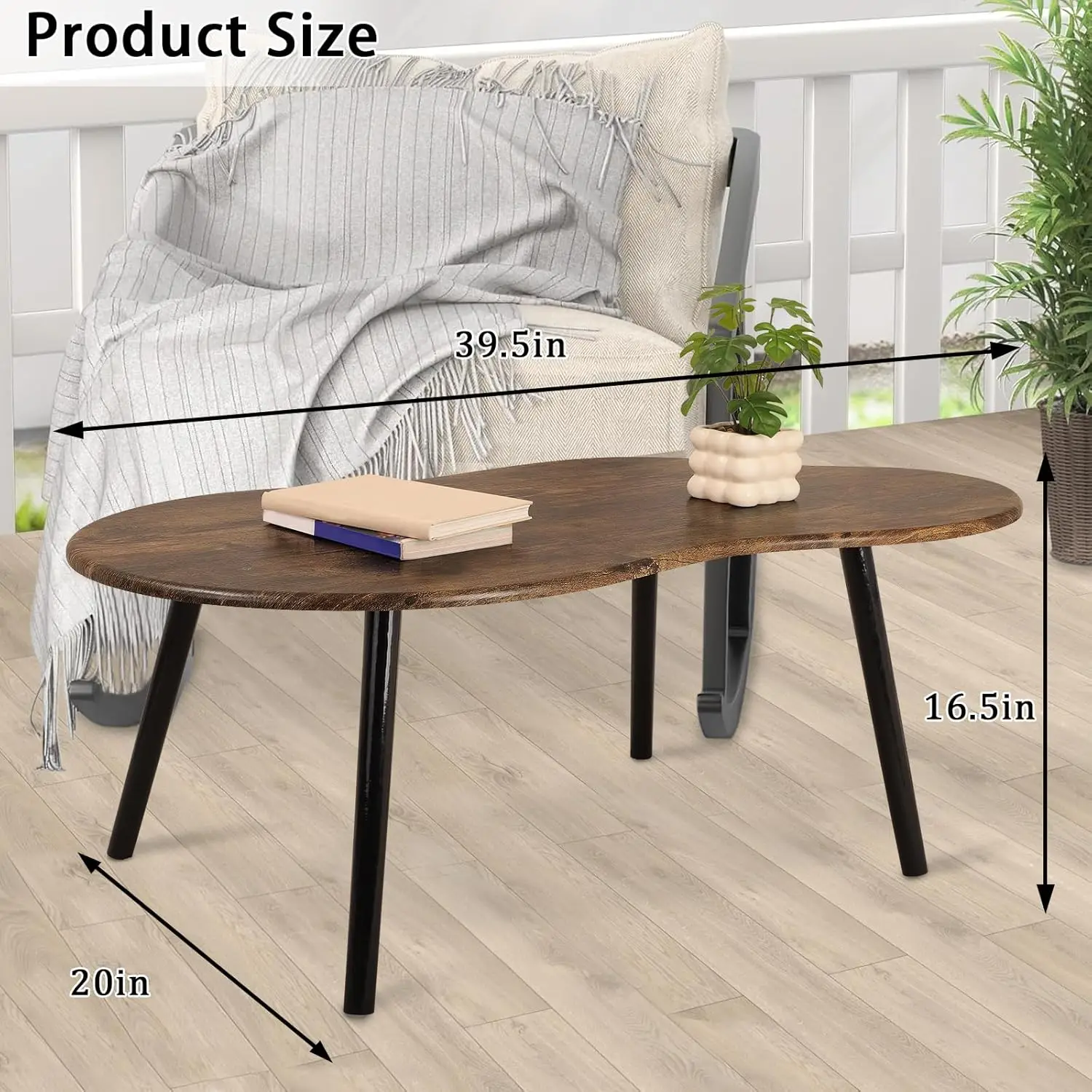
Exploring different round and oval mid-century coffee tables reveals how these sculptural forms evolved throughout the era, from early biomorphic experiments to more refined geometric interpretations in later years.
Sleek Minimalist Designs: Rectangular and Elliptical Tables
While sculptural pieces make bold statements, the sleek rectangular and elliptical black mid-century coffee tables represent perhaps the most enduring and versatile designs from this era. These pieces exemplify the movement’s commitment to refined simplicity and functional elegance.
Rectangular tables form the backbone of mid-century coffee table design, featuring:
- Clean, straight edges that create visual order and balance
- Carefully calculated proportions that feel neither too bulky nor too insubstantial
- Subtle details like beveled edges or slight tapers that add refined interest
- Practical dimensions that serve living spaces without overwhelming them
Elliptical designs offer a softer alternative while maintaining minimalist principles:
- Gentle curves that create fluid visual movement
- Absence of sharp corners for child-friendly safety and improved flow in smaller spaces
- Slightly narrower proportions that facilitate easier movement around the piece
- Visual lightness that works beautifully in compact living areas
The leg designs for these minimalist tables are particularly significant in defining their character:
- Hairpin legs: Ultra-slender metal supports that create visual lightness
- Tapered wooden legs: Angled supports that suggest motion and dynamic energy
- Splayed legs: Outward-angled supports that provide stability with playful geometry
- Pedestal bases: Central supports that maximize floor space and create elegant proportions
Black finishes accentuate these sleek forms by creating crisp silhouettes and highlighting the geometric precision of these designs. When applied to rectangular and elliptical tables, black creates a sophisticated foundation that can anchor diverse interior styles while maintaining its own distinct character.
The enduring popularity of rectangular mid-century coffee tables demonstrates how effectively these minimalist designs balance aesthetic appeal with practical functionality—a core principle of the mid-century modern movement.
Space-Saving Solutions: Nesting and Multi-Level Tables
Mid-century designers excelled at creating furniture that maximized functionality in the increasingly compact living spaces of post-war America. Black nesting and multi-level coffee tables exemplify this ingenious approach to space efficiency without sacrificing style.
Nesting tables represent one of the cleverest space-saving solutions from this era:
- Sets of two to three graduated tables that store compactly one beneath another
- Ability to expand for entertaining or separate for flexible use throughout a space
- Consistent forms with scaled proportions that create visual harmony
- Identical finishes that unify the set into a cohesive design statement
The black finish plays a crucial role in nesting sets by visually connecting tables that might have different materials or slightly varied designs. This cohesive treatment allows them to function as both a singular unit and as separate pieces distributed throughout a living space.
Multi-level tables offer another innovative approach to maximizing functionality:
- Stepped or tiered surfaces that provide distinct display areas
- Split-level designs that accommodate different activities simultaneously
- Surfaces at varied heights that create visual interest and practical utility
- Integrated storage solutions beneath upper levels for magazines or small items
These clever designs often incorporate asymmetry—a hallmark of mid-century creativity. A table might feature offset levels, cantilevered extensions, or irregular platform shapes, all unified by a sophisticated black finish that emphasizes their architectural quality.
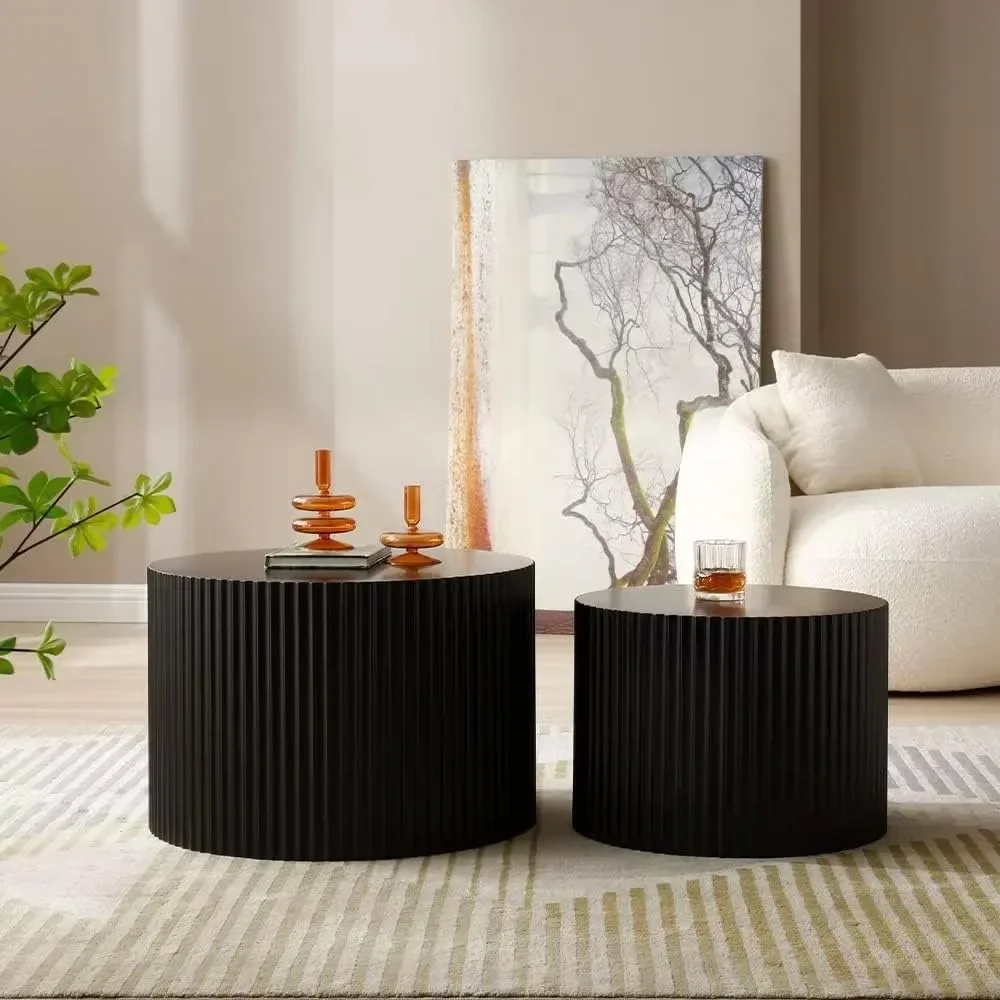
For today’s smaller living spaces, these vintage solutions remain remarkably relevant. Nesting coffee tables offer the flexibility modern homeowners need, while their distinctive mid-century profiles provide the character many contemporary spaces lack. Learning how to properly style black mid-century coffee tables helps maximize their visual impact regardless of space constraints.
Bold Geometric Statements: Drum and Cylinder Tables
Among the most distinctive silhouettes in the mid-century coffee table repertoire are the bold drum and cylinder designs. These substantial forms reject the lightness of many mid-century pieces in favor of grounded, architectural presence that anchors living spaces with confident simplicity.
Drum tables feature:
- Perfect circular tops with straight sides creating cylindrical forms
- Substantial visual weight that provides balance to lighter furniture elements
- Uninterrupted surfaces that showcase materials and finishes
- Absence of legs or supports, creating clean, monolithic forms
When rendered in black, these drum tables take on a sophisticated, almost sculptural quality. The continuous surface becomes a canvas that highlights the interplay of light and shadow, while the lack of visible supports creates a sense of solidity and permanence.
Various interpretations of the drum form emerged throughout the mid-century period:
- Solid wooden drums with subtle wood grain visible through black finishes
- Metal variations with textured or perforated surfaces for visual interest
- Composite materials formed into perfectly smooth cylinders
- Combination designs featuring contrasting materials for tops and sides
What makes these seemingly simple forms so effective is their perfect proportions. The height-to-width ratio is carefully calculated to create pieces that feel substantial without appearing bulky. The diameter typically allows for practical use while maintaining the bold geometric statement.
Many of these designs incorporate subtle functional elements that maintain their clean aesthetic:
- Hidden storage compartments accessed through nearly invisible seams
- Slight texture variations that add tactile interest without disrupting the form
- Minimal hardware that maintains the uninterrupted silhouette
For contemporary interiors, these round coffee tables continue to offer powerful design statements. Their geometric simplicity allows them to complement both vintage collections and contemporary furnishings with equal success.
Practical Elegance: Storage Coffee Tables with Black Finishes
Mid-century designers recognized that living spaces were becoming more multifunctional, creating an increased need for furniture that offered both beauty and utility. Storage coffee tables with black finishes represent this pragmatic approach to design—pieces that conceal practical solutions within elegant forms.
The genius of mid-century storage tables lies in how seamlessly they integrate functional elements without compromising aesthetics:
- Discreet drawers with minimal hardware that maintain clean lines
- Sliding panels that reveal interior compartments while preserving the table’s silhouette
- Open shelving that provides display space while maintaining visual lightness
- Hidden compartments accessed through clever mechanisms or lift-tops
Black finishes play a particularly important role in these multifunctional pieces by visually unifying different components. A table combining open shelving, closed storage, and display surfaces maintains cohesion through consistent black treatment across various elements.
These storage solutions were thoughtfully designed for specific purposes:
- Magazine shelves at perfect depths for periodicals
- Record storage sized precisely for album covers
- Divided compartments for organizing small items
- Deeper drawers for larger objects or occasional use items
The construction quality of these pieces ensured their durability despite regular use. Dovetailed drawers, precision-fit sliding panels, and quality hardware allowed these tables to maintain their functionality and appearance for decades—explaining why original pieces remain highly sought-after today.
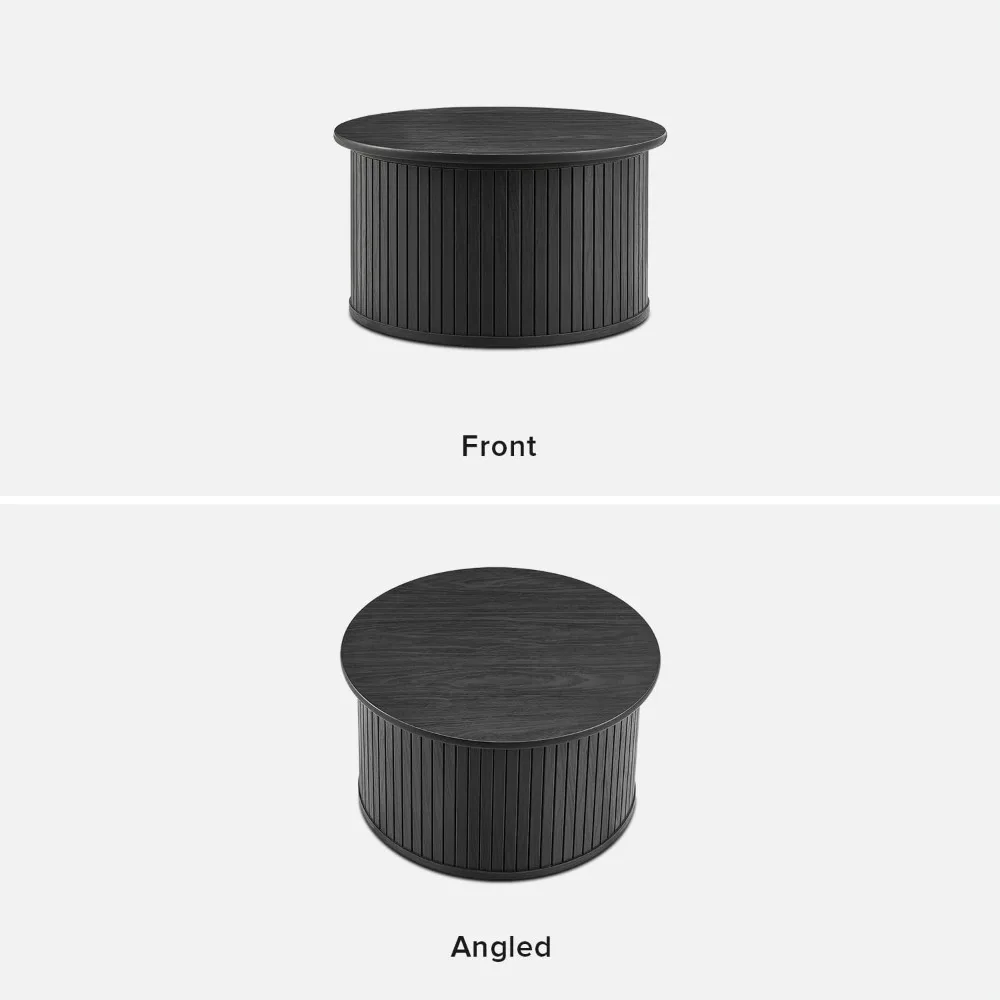
Modern interpretations of these classics, like lift-top coffee tables, continue to offer practical solutions for contemporary living while maintaining the sophisticated aesthetic that makes mid-century design so enduringly popular.
Mid-Century Modern Solid Wood Coffee Tables, Mid-Century Modern Teak Coffee Tables
$879.95 Select options This product has multiple variants. The options may be chosen on the product pageMid-Century Modern Danish Coffee Tables, Mid-Century Modern Oval Coffee Tables, Mid-Century Modern Solid Wood Coffee Tables
$390.05 Select options This product has multiple variants. The options may be chosen on the product pageMid-Century Modern Coffee & End Table Sets, Mid-Century Modern Coffee Table Sets, Mid-Century Modern Oval Coffee Tables
Price range: $257.48 through $331.04 Select options This product has multiple variants. The options may be chosen on the product pageMid-Century Modern Glass Top Coffee Tables, Mid-Century Modern Glass Top Side & End Tables
$460.58 Select options This product has multiple variants. The options may be chosen on the product pageMid-Century Modern Glass Top Coffee Tables, Mid-Century Modern Vintage Coffee Tables, Mid-Century Modern Vintage Side & End Tables
$725.36 Select options This product has multiple variants. The options may be chosen on the product pageMid-Century Modern Lift Top Coffee Tables, Mid-Century Modern Square Coffee Tables
$454.73 Select options This product has multiple variants. The options may be chosen on the product page
Selecting Your Ideal Black Mid-Century Coffee Table
Finding the perfect black mid-century coffee table involves careful consideration of both practical needs and aesthetic preferences. The right piece should complement your living space while providing the functionality your lifestyle demands.
Size and Scale Considerations
- Length: Ideally about two-thirds the length of your sofa for balanced proportions
- Height: Generally 16-18 inches, within 1-2 inches of your seating height for comfortable use
- Width: Typically 22-30 inches, allowing at least 14-18 inches of clearance around all sides
- Visual weight: Consider how substantial the table appears relative to your other furniture
Shape Selection Based on Room Layout
- Rectangular: Best for larger seating arrangements and traditional room layouts
- Round/Oval: Ideal for smaller spaces, rooms with children, or conversation-focused arrangements
- Square: Works well in balanced room layouts with equal seating on all sides
- Organic/Asymmetrical: Creates visual interest in minimalist spaces or as an artistic focal point
Material Selection for Lifestyle Needs
- Solid wood with black finish: Durable but may show scratches; adds warmth despite dark color
- Metal and glass: Contemporary look, easy to clean, but may show fingerprints and dust
- Stone surfaces: Extremely durable but heavier and often more expensive
- Engineered materials: Budget-friendly options with consistent appearance
Functionality Assessment
- Surface area: Consider how you’ll use the table (display only, active use for drinks/meals, etc.)
- Storage needs: Determine whether drawers, shelves, or hidden compartments would benefit your space
- Versatility: For smaller homes, consider multi-functional or nesting designs
- Maintenance requirements: Different materials and finishes require varying levels of care
Authentication and Quality Markers
- Joinery: Look for dovetail joints, mortise and tenon connections, or quality mechanical fasteners
- Finish consistency: Check for even application and proper sealing, especially on black surfaces
- Material quality: Assess the weight, stability, and material thickness
- Design integrity: Authentic mid-century pieces feature thoughtful proportions and details
Understanding the nuances of decorating with black mid-century coffee tables can help guide your selection process. Exploring different black mid-century modern coffee table styles provides inspiration for finding a piece that will complement your specific interior design approach.
Finding Quality Black Mid-Century Coffee Tables: Sourcing Guide
The search for the perfect black mid-century coffee table offers various paths depending on your preferences for authenticity, budget, and availability. Understanding where to look and what to evaluate ensures you’ll find a piece that brings lasting value to your home.
Vintage and Authentic Sources
When seeking genuine mid-century pieces:
- Estate sales and auctions often yield undiscovered treasures at reasonable prices
- Specialized vintage furniture dealers offer curated selections with authentication
- Online marketplaces dedicated to vintage furnishings provide wider selection but require careful evaluation
- Antique shows feature vetted dealers with knowledge of mid-century specifics
Quality Reproductions
For those seeking mid-century style with modern manufacturing standards:
- Specialized retailers like Hearth Forms offer carefully curated reproductions that honor original designs
- Design-focused furniture stores often carry mid-century inspired collections
- Custom furniture makers can create pieces inspired by mid-century aesthetics with personalized dimensions
Evaluating Quality and Authenticity
Whether vintage or contemporary, quality indicators include:
- Construction integrity: Examine how pieces are joined, the quality of hardware, and overall stability
- Material authenticity: Period-appropriate materials for vintage pieces; quality materials for reproductions
- Finish quality: Even application, appropriate sheen level, and durability of black finishes
- Design proportions: Authentic mid-century pieces feature thoughtful, intentional proportions
- Weight and balance: Quality pieces have appropriate heft and stability
Vintage vs. Contemporary Considerations
Factors to weigh when deciding between vintage and new:
- Patina and character: Vintage pieces offer history and unique wear patterns
- Structural integrity: New pieces may offer better stability for active households
- Size standardization: Contemporary pieces often better match modern sofa heights
- Material sustainability: Both options offer environmental benefits (reuse vs. modern sustainable sourcing)
The hunt for exceptional vintage mid-century coffee tables often requires patience but yields pieces with unique character and historical significance. For those seeking immediate solutions, quality reproductions offer the aesthetic appeal of mid-century design with contemporary construction standards.
Creating a Cohesive Look: Styling Your Black Coffee Table
A black mid-century coffee table provides an excellent foundation for creating a stylish, cohesive living space. The right styling approach can enhance its distinctive design while ensuring it integrates beautifully with your overall interior scheme.
Complementary Color Palettes
Black tables offer exceptional versatility with various color combinations:
- Neutral harmony: Pair with whites, grays, and beiges for sophisticated minimalism
- Warm contrasts: Combine with caramel leather, brass accents, and warm woods for mid-century authenticity
- Bold statements: Accent with vibrant oranges, teals, or yellows for energetic mid-century pop
- Natural balance: Integrate houseplants and natural elements to soften the black finish
Effective Accessorizing Techniques
The flat surface of a coffee table offers prime styling real estate:
- Rule of three: Group objects in odd numbers (typically three) for visual balance
- Height variation: Include items of different heights to create visual interest
- Tactile contrast: Mix materials like ceramics, books, and natural elements against the black surface
- Negative space: Allow some empty surface to prevent overcrowding and maintain functionality
- Personal touches: Include meaningful objects that tell your story and create conversation pieces
Balancing Elements
Creating harmony between your black coffee table and surrounding elements:
- Textile softening: Add textural contrast with area rugs that complement the table’s geometric form
- Light reflection: Position table lamps or candles to create subtle reflections on black surfaces
- Scale consideration: Choose accessories proportional to your table size (larger tables can handle bigger objects)
- Functional grouping: Create intentional vignettes for different activities (reading corner, drink station, etc.)
Seasonal Refreshes
Keep your styling current with seasonal adjustments:
- Spring/Summer: Incorporate fresh flowers, lighter colors, and natural elements
- Fall/Winter: Add warmer tones, textured objects, and softer lighting elements
- Rotate books: Change displayed books to reflect seasonal themes or current interests
- Adjust vessels: Switch between lighter glass containers and heavier ceramics based on the season
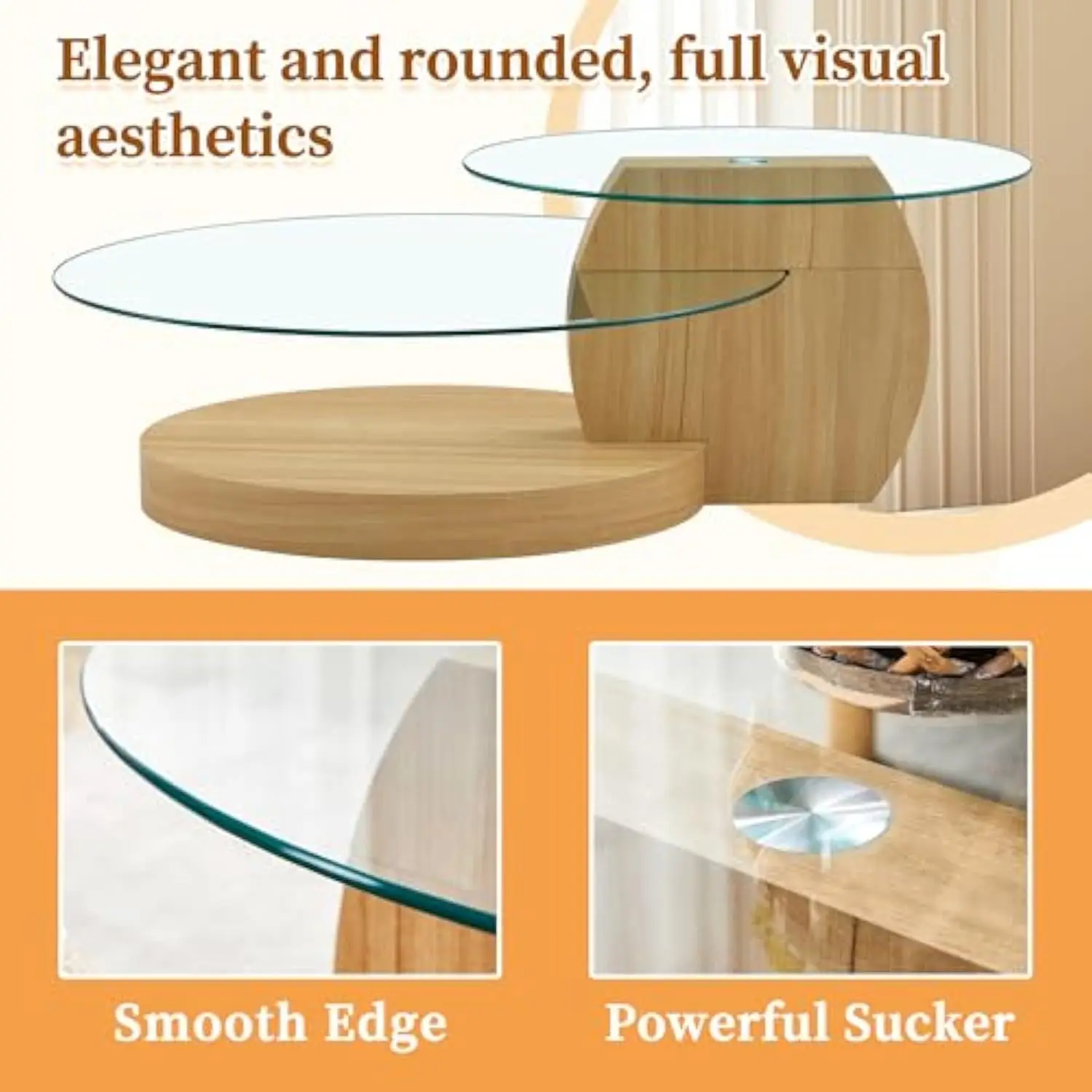
Learning approaches to maximizing black mid-century coffee tables in smaller spaces can help you create impactful arrangements regardless of your room dimensions. The table’s design often determines the most effective styling approach, with different shapes requiring distinct accessorizing strategies.
Maintaining the Beauty: Care for Black Mid-Century Coffee Tables
Preserving the striking appearance of a black mid-century coffee table requires appropriate care tailored to its specific materials. Proper maintenance ensures these design classics will continue to enhance your space for years to come.
Wood Care for Black Finishes
For black-finished wooden tables:
- Dust regularly with a soft, lint-free cloth to prevent buildup that can scratch surfaces
- Clean with a slightly damp cloth and mild soap solution, drying immediately afterward
- Apply furniture polish specifically formulated for dark woods every 3-6 months
- Address water rings quickly by applying a mixture of equal parts white vinegar and olive oil
- Prevent direct sunlight exposure, which can fade black finishes over time
Metal Component Care
For tables with black metal elements:
- Dust regularly with a soft cloth to remove particles that could scratch coatings
- Clean with a damp microfiber cloth, avoiding abrasive cleaners that could damage finishes
- Apply a thin coat of paste wax annually to protect powder-coated or painted metal surfaces
- Address any chips in black finishes promptly to prevent rust or corrosion
- Use felt pads where metal components contact wooden parts to prevent wear
Glass Surface Maintenance
For tables with glass components:
- Clean with a quality glass cleaner and microfiber cloth for streak-free results
- Address fingerprints regularly, as they’re more visible against black bases
- Check and tighten any hardware securing glass components to prevent movement
- Use coasters to prevent condensation rings where glass meets wooden elements
- Consider occasional edge polishing for tables with beveled or specialized glass treatments
Stone Surface Protection
For tables with black stone elements:
- Apply stone sealer annually to prevent staining, especially on porous surfaces like marble
- Clean with stone-specific products that won’t etch or damage natural materials
- Use coasters religiously to prevent acidic drinks from causing permanent damage
- Address spills immediately to prevent absorption into even sealed stone
- Dust regularly to prevent micro-scratches from particles left on the surface
Understanding how different styles complement mid-century modern furniture can help inform your overall approach to room design, ensuring your well-maintained coffee table remains a central design element in your space for years to come.
Why Black Mid-Century Coffee Tables Remain Relevant Today
The enduring appeal of black mid-century coffee tables speaks to the thoughtful design principles that transcend passing trends. These pieces continue to feel fresh and relevant in contemporary interiors for several compelling reasons.
At their core, black mid-century coffee tables represent a perfect balance of form and function—a design philosophy that remains as relevant today as it was during their original creation. Their clean lines and uncluttered forms align perfectly with our current appreciation for intentional simplicity and purposeful design.
The versatility of these tables allows them to adapt to evolving interior styles while maintaining their distinctive character. Their restrained aesthetic means they can complement minimalist, Scandinavian, industrial, or eclectic spaces with equal success. This adaptability makes them wise investments in an era when interior trends change rapidly.
From a sustainability perspective, these designs offer remarkable longevity. Their durable construction and timeless aesthetic mean they avoid the disposal cycle of more trend-driven furniture pieces. Whether investing in a vintage original or a quality reproduction, these tables represent a more sustainable approach to home furnishing—pieces intended to last for generations rather than seasons.
The black finish particularly contributes to their enduring appeal. While wood tones and other colors may feel dated to specific eras, black maintains a sophisticated presence that transcends periods. This color choice allows the tables’ distinctive forms to remain the focal point while integrating seamlessly with changing color trends in other furnishings.
Perhaps most importantly, these tables connect us to design principles that value quality, craftsmanship, and thoughtful innovation. In an age of mass production and disposable furnishings, black mid-century coffee tables remind us that great design requires intention and that beautiful objects deserve to be both functional and lasting.
For those seeking to create living spaces with genuine character and design integrity, black mid-century coffee tables continue to offer an accessible entry point to furniture with authentic heritage and enduring relevance.

